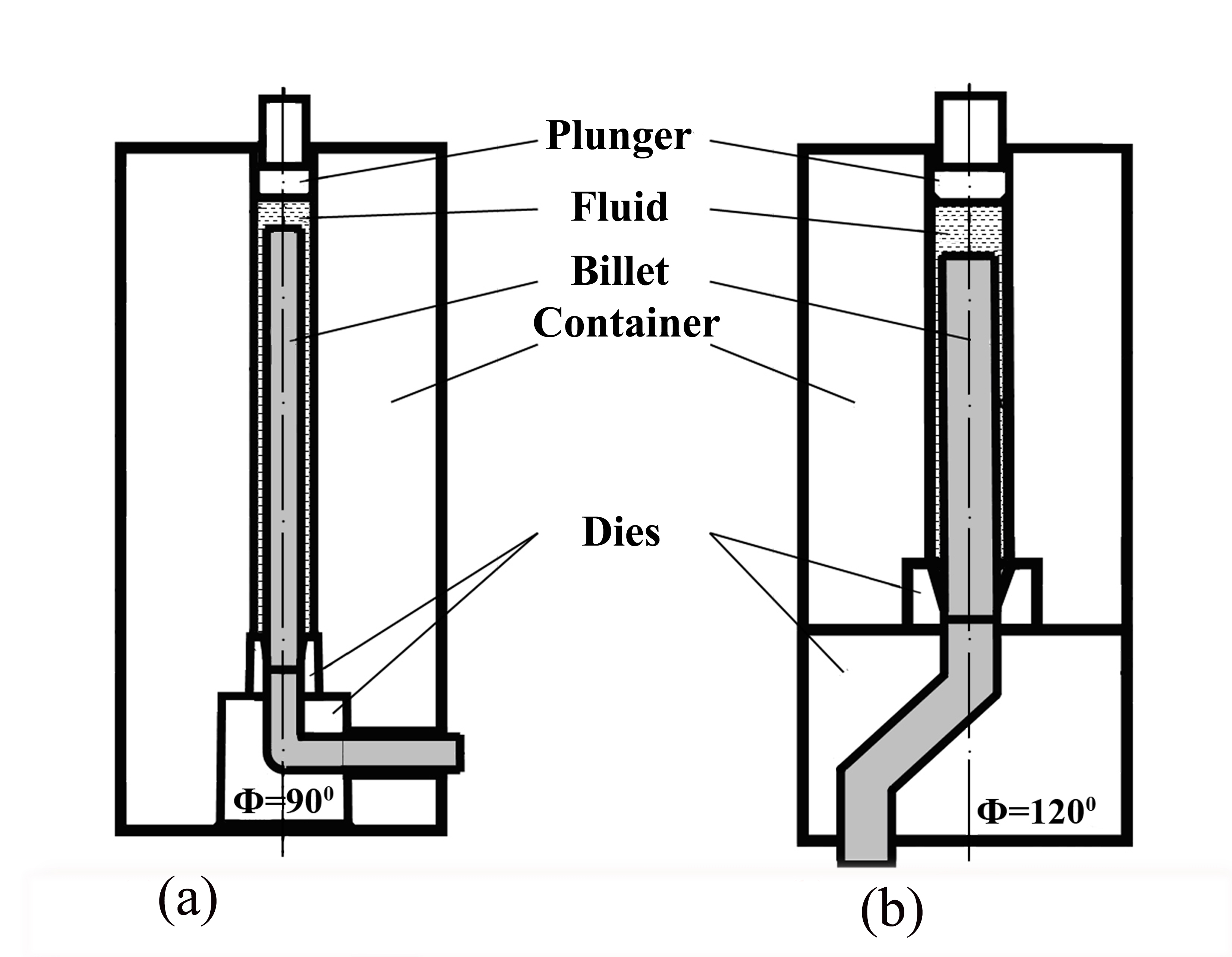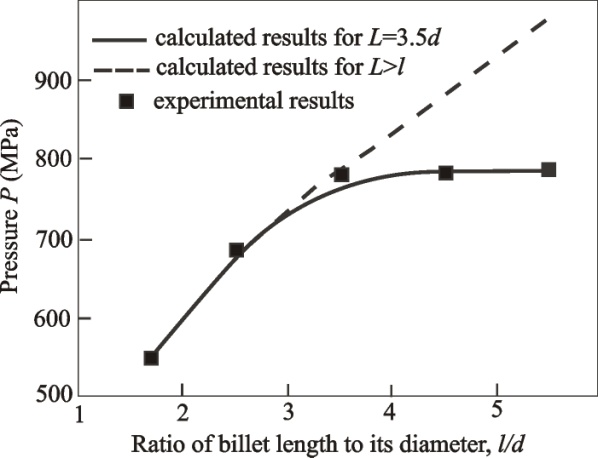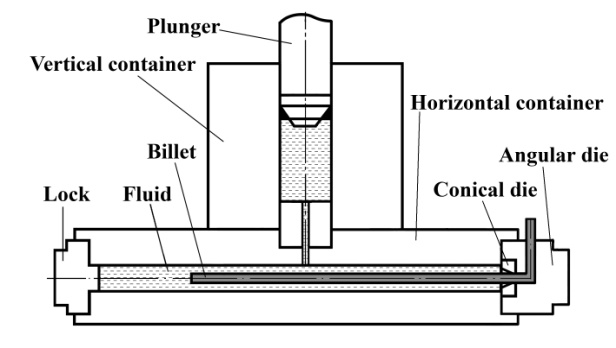-
Paper Information
- Next Paper
- Previous Paper
- Paper Submission
-
Journal Information
- About This Journal
- Editorial Board
- Current Issue
- Archive
- Author Guidelines
- Contact Us
International Journal of Materials and Chemistry
p-ISSN: 2166-5346 e-ISSN: 2166-5354
2012; 2(4): 145-150
doi: 10.5923/j.ijmc.20120204.06
ECAE Methods of Structure Modification of Materials
Viktor Beloshenko , Victor Spuskanyuk
Donetsk Institute for Physics and Engineering, National Academy of Sciences of Ukraine, Donetsk, 72 R.Luxemburg St., 83114, Ukraine
Correspondence to: Viktor Beloshenko , Donetsk Institute for Physics and Engineering, National Academy of Sciences of Ukraine, Donetsk, 72 R.Luxemburg St., 83114, Ukraine.
| Email: |  |
Copyright © 2012 Scientific & Academic Publishing. All Rights Reserved.
Equal-channel angular extrusion (ЕСАЕ) is one of the most efficient methods of severe plastic deformation of materials. The possibilities of structure modification of materials of different nature (metals, polymers) by new varieties of ECAE, equal-channel angular hydroextrusion (ECAH) and equal-channel multiple-angular extrusion (ECMAE) are investigated. Devices and technique of ECAH and ECMAE are described. The use of this methods ensured strength σт = 686 MPa, elongation to failure δ = 2% and electrical conductivity at the level of 86.4% IACS for a copper wire of 0.5-mm in diameter, up to two times increase in critical current density and slightly influences the temperature of the transition to the superconducting state of NbTi alloy, up to several times increase in microhardness, rigidity and strength of polymers with conserved high level of plasticity.
Keywords: Equal-Channel Multiple Angular Extrusion, Equal-Channel Angular Hydroextrusion, Technique, Metal, Polymer, Properties
Cite this paper: Viktor Beloshenko , Victor Spuskanyuk , "ECAE Methods of Structure Modification of Materials", International Journal of Materials and Chemistry, Vol. 2 No. 4, 2012, pp. 145-150. doi: 10.5923/j.ijmc.20120204.06.
Article Outline
1. Introduction
- Equal-channel angular extrusion (ЕСАЕ) is one of the most efficient methods of severe plastic deformation (SPD) permitting accumulation of high plastic deformation with remained form and size of a sample. Traditional ЕСАЕ reaches this effect by extrusion of a billet through a matrix consisting of two channels with equal cross-sections intersecting usually at the angle of 90[1-5. Metal processing causes intensive fragmentation of the grains and formation of submicrocrystal or nanocrystal structure. In the case of high-molecular compounds, macromolecules become oriented along the deformation axis[6-8. As a result of structure transformations, the set of parameters of the mentioned subjects can be significantly improved and states with unique combination of physical and mechanical characteristics can be realized. Determined by technical and commercial attraction of the method, active interest of researchers in ECAE contributed to its development. Side by side with the traditional ЕСАЕ scheme, S-shape extrusions, the process using a rotary-die, the side-extrusion process, ECAE-conform process have been suggested[5].There are other potential variants of ЕСАЕ application, in particular, equal-channel multiple-angular extrusion (ЕСМАЕ), equal-channel angular hydroextrusion (ЕСАН), as well as combined methods of processing based on them. Unlike to the enlisted methods, they are not so well known. The aim of this paper is to make the results of our investigation visible and accessible to new audiences around the word. The present paper is focused on possibilities of the listed technological processes with respect to the materials of different nature (metals, polymers) for the sake of efficient application of promising methods of SPD.
2. ECAH Method
- A new version of ECAE, called equal-channel angular hydroextrusion, and the facility for ECAH were suggested in[9]. ECAH implies that a billet is extruded through the die channel by fluid pressure. The basic features of ECAH have been investigated using the facilities shown in Figure 1[9],[10].The main part of the facilities is the high-pressure container with the operating pressure up to 1.6 GPa. In Figure 1(a), a conical die and an angular die are located in the lower part of the container channel. The conical die channel and the input segment of the angular die channel are aligned with the high pressure container channel. The conical die is placed before the angular die in order to provide billet centring during its insertion into the container channel. In addition, the fluid should be sealed at the interface between the conical die and the billet. In the case illustrated by Figure 1(b), the high-pressure container and the S-type angular die are pressed in the common belt (not shown).The diameters of the conical die calibrating bore and the input segment of the angular die channel are equal. The diameter of the output segment of the angular die channel was made slightly larger than the diameter of the input segment for repetitive ECAH without any additional operations of billet thickening before each pass through the conical die.
 | Figure 1. The scheme of the ECAH facilities with (a) one and (b) two deformation zones |
 | Figure 2. Calculated and experimental ECAH pressures of copper billets versus the ratio of the billet length l to its diameter d |
 | Figure 3. The scheme of the ECAH facility with connected vertical and horizontal containers |
 | Figure 4. Effect of ECAH (Φ = 90°) on copper properties |
3. ECMAE Method
- ECMAE is a sort of ECAE realized by pressing of a billet through the channel where several zones of shear deformation are organized by intersection of channel segments at ordered angles[3],[11-13]. ECMAE enhances labour productivity of treatment in comparison with multi-pass ECAE of billets in devices with one shear zone. At the same total strain of billets, ECMAE and multi-pass ECAE give the similar resulting changes of microstructure and hardness[3]. A significant drawback of ECMAE is the increase of the surface of contact friction of billets with the instrument and determined higher pressure of deformation.Experiments have shown that the development of homogeneous microstructure with the grain boundaries having high angles of misorientation requires intense plastic strain during ECAE and therefore, it is necessary that the angle Φ should be equal to, or very close to 90°[14]. Therefore, Nakashima et al.[3] suppose that the construction of any multi-pass die requires that each separate plane is associated with an angle Φ close to 90°. We have developed ECMAE device where large angles (Φ=110…160°) are used along with Φ=90°, so technological abilities of the method become expanded. The deforming block has the form of a set of thick-walled deforming disks with intersecting channels of the same diameter (Figure 5)[13]. Channels of the container and the lower deforming disk are vertically coaxial. Pair of disks with inclined channels form so-called bend. When using several pairs of deforming disks, the position of the bend can be changed by turning disks about the vertical axis.
 | Figure 5. The scheme of the ECMAE facility |
 is the average value of microhardness measured at cross-section; Е, σт, εт are modulus of elasticity, ultimate tensile strength and deformation of destruction measured at tension.It follows from Table 1 that in the case of polymers, not only the temperature and the value of accumulated deformation but also the routes of the process are of significant importance for the improvement of the set of the properties. E route is the most preferred among the considered ones because of provided higher level of physical and mechanical characteristics.
is the average value of microhardness measured at cross-section; Е, σт, εт are modulus of elasticity, ultimate tensile strength and deformation of destruction measured at tension.It follows from Table 1 that in the case of polymers, not only the temperature and the value of accumulated deformation but also the routes of the process are of significant importance for the improvement of the set of the properties. E route is the most preferred among the considered ones because of provided higher level of physical and mechanical characteristics.
|
4. Combined Processing of Materials
4.1. Production of High-Strength and High-Conductivity Copper Wire with Using of ECAH Method
- In[10, for the first time, it was demonstrated by the example of copper that combination of the ECAH, hydroextrusion (HE) and drawing (D) techniques provides higher properties of wire as compared to properties obtained without ECAH. Commercial Cu-FRTP (fire refined tough pitch copper) hot-pressed rods of 50 and 60 mm in diameter were used. When rods of 50-mm diameter were used, ECAH applied (scheme of HE+ECAH+HE+D) to the production of 0.5-mm diameter copper wire resulted in a higher level of the ultimate tensile strength (σт=546 MPa) and the elongation to failure (δ = 2.4%), as compared to σт = 474 MPa and δ=1.4% obtained without ECAH. It was also ascertained that these properties of copper wire were practically preserved for 18 months. When rods of 60-mm in diameter were used, the repetitive HE and ECAH techniques (scheme of HE+ECAH+HE+ECAH+HE+D) resulted in a higher level of copper wire strength as compared to the result obtained with single ECAH technique. In this case, σт = 686 MPa and elongation to failure δ = 2% was achieved for a copper wire of 0.5-mm in diameter. The ECAH does not result in a considerable growth of resistivity. The electrical properties of the highest strength copper wire produced with ECAH and hardened wire produced without ECAH differ negligibly. The repetitive application of HE and ECAH techniques in technological chain of copper treatment in fractional mode and with the optimal degrees of deformation formed a unique complex of physical and mechanical properties, such as σт = 686 MPa and electrical conductivity at the level of 86.4% IACS, which is the record for the copper and copper alloys. Such strength is almost 1.5 times as much as that of copper subjected to monotonous deformation[10, 19]. The proposed combined treatment is efficient due to alternative schemes of deformation and periodic creation of favourable conditions for relaxation and dynamic recrystallization processes in the material. High plastic deformation by the simple shear scheme results in saturation of grain refinement and metal hardening. But with further processing of the billets, the method of HE provides a higher degree of material hardening, whereas ECAH implies conditions for stress relaxation, healing of micro-discontinuities and smaller exhaustion of plastic resource.
4.2. Effects of Combined Processing of the NbTi Alloy with Use of ECMAE
- Bimetal hot-pressed rods of the Nb−60 at.% Ti alloy wrapped by copper shell were used as initial billets. The alloy was of two-phase composition, being β-solid solution of bcc lattice with small volume fraction (~1%) of hexagonal α-phase. Test wire samples were prepared by two schemes, i.e. the traditional one (hydroextrusion + drawing) and with the additional use of ECMAE[20.It was established that ECMAE included to the traditional scheme of processing of a superconductor results in formation of highly homogeneous nanostructure with dispersed texture and high density of grain boundaries that facilitates nucleation of α-phase and contributes to activation of β-matrix decomposition with precipitation of the secondary hexagonal α-phase at the rate of increase in nucleation place and reduction in diffusion ways of the Ti atoms[20, 21. As a result of combined deformation with ECMAE use, significant strengthening of the alloy (up to 30%) takes place and percent elongation of bimetal superconducting wire produced on this basis is increased by 25%[22. Included to the technological scheme of the NbTi superconductor processing, ECMAE results in significant (up to two times) increase in critical current density and slightly influences the temperature of the transition to the superconducting state. At that, the density of the critical current of the samples obtained with using ECMAE compared to that of the samples without such processing is higher practically within the whole tested range of magnetic fields irrespective of the duration of thermal treatment[20, 21, 23.
4.3. Effects of Combined Processing of Polymers with the Use of ЕСМАЕ
- In[24],[25, by the example of polyamide-6 (PA-6), potentialities of combined schemes of solid-phase extrusion were considered including extrusion through a conic die (ЕD) and ЕСМАЕ at varied succession. Table 2 contains data of microhardness measurements and extension tests selected from the mentioned papers. Here, εЕСМАЕ, εЕД are deformation degrees at ЕСМАЕ and ЕD, correspondingly;
 are the average values of microhardness measured at longitudinal and transversal sections of the samples;
are the average values of microhardness measured at longitudinal and transversal sections of the samples;  is the value characterizing anisotropy of microhardness. The data of Table 2 allowed us to make a conclusion that the use of ED+ECMAE scheme realizes the state with the highest values of microhardness and the minimal anisotropy, at the same time. At that, high values of modulus of elasticity and ultimate tensile strength are achieved with conserved high level of plasticity.
is the value characterizing anisotropy of microhardness. The data of Table 2 allowed us to make a conclusion that the use of ED+ECMAE scheme realizes the state with the highest values of microhardness and the minimal anisotropy, at the same time. At that, high values of modulus of elasticity and ultimate tensile strength are achieved with conserved high level of plasticity.
|
5. Conclusions
- The results enlisted in the paper give evidences that ECAH and ECMAE substantially advance facilities of ECAE, so they are recommended first of all for processing of polymers, hardly-deformed metal materials, bimetallic and multimetallic billets (ECMAE), long metal rods (ECAH), when ECAE is not effective. Applied to metals, polymers and composites, combination of the mentioned methods of pressure treatment with the traditional ones (hydroextrusion, drawing) allows realization of structure states with the maximum level of physical and mechanical properties.
 Abstract
Abstract Reference
Reference Full-Text PDF
Full-Text PDF Full-Text HTML
Full-Text HTML
